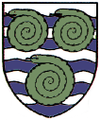Whitby
| Whitby | |
|---|---|
 Whitby and River Esk |
|
 Arms of Whitby Town Council featuring three green ammonites. |
|
| Whitby shown within North Yorkshire | |
| Population | 13,213 (2011 census) |
| OS grid reference | NZ893109 |
| Civil parish |
|
| District | |
| Shire county | |
| Region | |
| Country | England |
| Sovereign state | United Kingdom |
| Post town | WHITBY |
| Postcode district | YO21, YO22 |
| Dialling code | 01947 |
| Police | North Yorkshire |
| Fire | North Yorkshire |
| Ambulance | Yorkshire |
| EU Parliament | Yorkshire and the Humber |
| UK Parliament | |

Lighthouses on the East and West Piers, and beacons on the pier extensions
|
|
| Location | Whitby North Yorkshire England |
|---|---|
| Coordinates | 54°29′34″N 0°36′46″W / 54.492814°N 0.612889°W |
| Year first constructed | 1831 (first) |
| Year first lit | 1914 (current) |
| Construction | wooden tower (current) stone tower (first) |
| Tower shape | cylindrical lantern on a four legs skeletal structure (current) cylindrical tower with balcony and lantern (first) |
| Markings / pattern | red lantern, unpainted structure (current) unpainted tower, white lantern, black lantern dome (first) |
| Height | 7 metres (23 ft) (current) 25 metres (82 ft) (first) |
| Focal height | 14 metres (46 ft) (current) |
| Range | 5 nmi (9.3 km; 5.8 mi) |
| Characteristic | F G (current) occasionally F G (first) |
| Fog signal | 1 blast every 30s |
| Admiralty number | A2599 (current) A2599.2 (first) |
| NGA number | 1984 (current) |
| ARLHS number | ENG-165 (first) |
| Managing agent | Whitby Harbour |
| Heritage | Grade II listed |
| Coordinates | 54°29′34″N 0°36′43″W / 54.492823°N 0.611813°W |
|---|---|
| Year first constructed | 1855 (first) |
| Year first lit | 1914 (current) |
| Deactivated | 1914 (first) |
| Construction | wooden tower (current) stone tower (first) |
| Tower shape | cylindrical lantern on a four legs skeletal structure (current) cylindrical tower with balcony and lantern (first) |
| Markings / pattern | red lantern, unpainted structure (current) unpainted tower, white lantern, black lantern dome (first) |
| Height | 7 metres (23 ft) (current) 17 metres (56 ft) (first) |
| Focal height | 14 metres (46 ft) (current) |
| Range | 5 nmi (9.3 km; 5.8 mi) |
| Characteristic | F R (current) |
| Fog signal | 1 blast every 30s |
| Admiralty number | A2598 (current) |
| NGA number | 1988 (current) |
| ARLHS number | ENG-163 (first) |
| Managing agent | Whitby Harbour |
| Heritage | Grade II listed |
Whitby is a seaside town, port and civil parish in the Borough of Scarborough and English county of North Yorkshire. It is located within the historic boundaries of the North Riding of Yorkshire. Situated on the east coast of Yorkshire at the mouth of the River Esk, Whitby has an established maritime, mineral and tourist heritage. Its East Cliff is home to the ruins of Whitby Abbey, where Cædmon, the earliest recognised English poet, lived. The fishing port developed during the Middle Ages, supporting important herring and whaling fleets, and was (along with the nearby fishing village of Staithes) where Captain Cook learned seamanship.
Tourism started in Whitby during the Georgian period and developed further on the arrival of the railway in 1839. Its attraction as a tourist destination is enhanced by its proximity to the high ground of the North York Moors National Park, its Heritage Coastline and by its association with the horror novel Dracula. Jet and alum were mined locally. Whitby Jet, which was mined by the Romans and Victorians, became fashionable during the 19th century.
The earliest record of a permanent settlement is in 656, when as Streanœhealh it was the place where Oswy, the Christian king of Northumbria, founded the first abbey, under the abbess Hilda. The Synod of Whitby was held there in 664. In 867, the monastery was destroyed by Viking raiders. Another monastery was founded in 1078. It was in this period that the town gained its current name, Whitby (from "white settlement" in Old Norse). In the following centuries Whitby functioned as a fishing settlement until, in the 18th century, it developed as a port and centre for shipbuilding and whaling, the trade in locally mined alum, and the manufacture of Whitby jet jewellery.
...
Wikipedia

